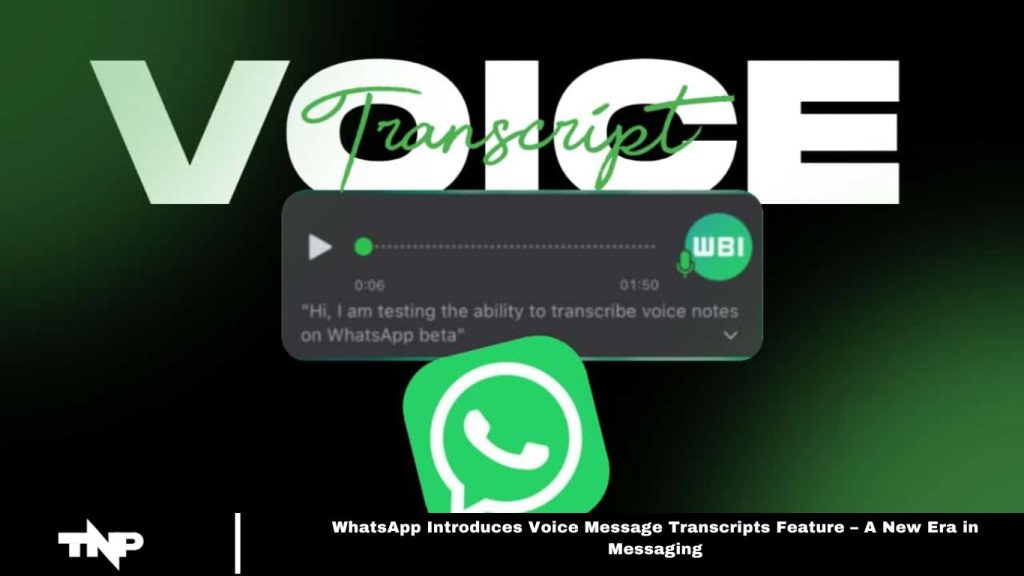WhatsApp, the leading messaging app globally, has launched a game-changing feature: voice message transcripts. After extensive testing, this feature is now available worldwide, simplifying voice message comprehension and response. In this article, we’ll explore how the feature enhances accessibility and what it means for the future of messaging.
What is the new feature?
The new voice message transcripts feature automatically converts voice messages into text, eliminating the need to listen to the entire message. When a voice message is played, a “transcribe” button appears, generating a transcript on the screen. This feature is available for both iOS and Android users.
Read More: WhatsApp rolling out Share status updates to Facebook feature for beta Android users.
Benefits of the new feature
The feature’s key benefit is enhancing accessibility for non-native speakers who struggle to understand voice messages in various languages. Transcripts allow users to easily read and comprehend content, fostering more inclusive communication. It also aids individuals who are deaf or hard of hearing, providing a text alternative to audio.
Additionally, transcripts enable quick searches for specific information within voice messages, benefiting busy professionals who need to extract key details swiftly. The feature also improves collaboration and productivity by making it easier to share important messages and information.
SEO benefits
The new feature also offers SEO benefits. Text transcriptions help search enginesn better index the content of voice messages, boosting the app’s search engine rankings. Additionally, transcripts make it easier for users to locate specific content within messages, increasing the likelihood of content being shared and linked across websites, ultimately enhancing the app’s visibility.
Implications for the future
The voice message transcripts feature is a game-changer for messaging apps, and other platforms are likely to follow WhatsApp’s lead by introducing similar features. This could signal a shift from voice to text-based communication, with users increasingly favoring the convenience of reading over listening to messages.
Businesses may also adopt messaging apps as their preferred communication tool, as text-based messaging is widely favored in professional settings. Additionally, the feature could pave the way for new, entirely text-based apps where typing takes precedence over speaking. This trend is already visible in platforms like Slack and Microsoft Teams, which are primarily text-focused.
Frequently Asked Questions
What is the WhatsApp voice message transcripts feature?
The voice message transcripts feature automatically converts voice messages into text, allowing users to read the content instead of listening to it.
How does the voice message transcript feature work?
When a voice message is played, a “transcribe” button appears. Tapping it generates a transcript of the message, which is displayed on the screen.
Is the voice message transcripts feature available on both iOS and Android?
Yes, the feature is available for both iOS and Android users.
What are the benefits of the voice message transcripts feature?
This feature makes WhatsApp more accessible to non-native speakers and people who are deaf or hard of hearing. It also helps users search for specific information within voice messages and facilitates easier content sharing.
Can I search within voice message transcripts?
Yes, the transcript feature allows users to search for specific content within voice messages, making it easier to find essential details.
Does this feature improve WhatsApp’s SEO?
Yes, the transcriptions improve WhatsApp’s SEO by making the content within voice messages indexable by search engines, potentially boosting the app’s search engine rankings.
Will other messaging apps adopt similar features?
It’s likely. Given WhatsApp’s innovation, other messaging apps may follow suit and introduce similar voice-to-text features in the future.
Can businesses use this feature?
Yes, businesses can benefit from this feature, which makes communication more accessible and easier to manage in professional settings where text-based communication is preferred.
Will this feature lead to a shift from voice to text messaging?
The feature could encourage more users to opt for text-based communication, making it more likely that messaging apps will become increasingly text-focused.
Are there any privacy concerns with the voice message transcripts?
As with any new feature, users shouldpp’s privacy policies to ensure that their data is protected. The app is committed to end-to-end encryption for voice messages and transcripts.
Conclusion
WhatsApp’s voice message transcripts feature is a significant enhancement that improves accessibility, convenience, and searchability within the app. By allowing users to read voice messages, WhatsApp caters to non-native speakers, individuals who are deaf or hard of hearing, and busy professionals.
Additionally, this feature could influence the future of messaging, with the potential for a shift from voice to text-based communication. As other messaging platforms follow suit, this innovation marks a pivotal moment in how we communicate, making interactions more inclusive and efficient for all users.

